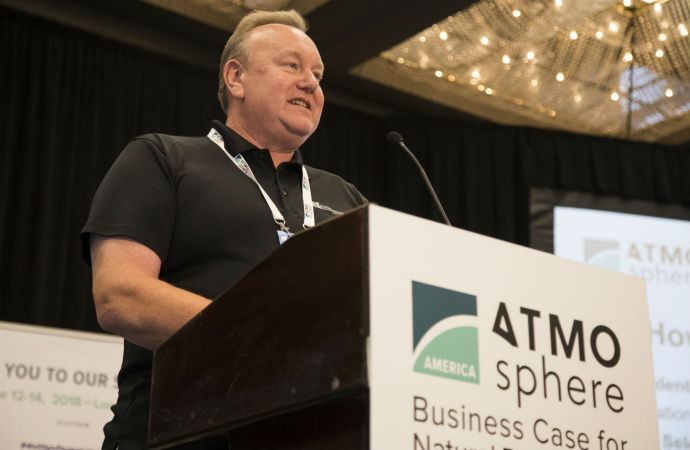CO2 system efficiency can approach that of NH3, says U.S. operator
April 24, 2019
Henningsen Cold Storage improves efficiency of transcritical system after commissioning.

In June of 2018, Henningsen Cold Storage, Hillsboro, Ore., installed its first transcritical CO2 system – and one of the first industrial transcritical systems in the U.S. – at a 111,000-sq-ft plant in Grandview, Wash.
At the IIAR Natural Refrigeration Conference & Expo, held March 4-6 in Phoenix, Ariz., Pete Lepschat, director of engineering for Henningsen, offered an update on the system’s performance so far. He was joined by Chris Herzog, principal, Industrial Refrigeration Equipment Partners.
Lepschat and Herzog provided an energy comparison between the transcritical CO2 system in Grandview and a very efficient low-charge ammonia system installed at a plant in Salem, Ore., in 2017. Their conclusion: CO2 efficiency can approach a very high level of NH3 efficiency with proper design features.
Henningsen’s highly efficient facilities average 0.48 kW/cu ft/yr, compared to an IARW industry average of 1.21. The Salem plant is its most efficient, at 0.26, and one of the most efficient in the cold-storage industry.
On a first-cost basis, adjusted for facility size, Henningsen found the cost of construction and refrigeration to be about 6% less at the CO2 facility, which required 5-6 weeks less construction time.
On an energy basis, the CO2 facility initially had much higher energy costs than the ammonia facility, owing to the high ambient temperatures experienced from June to August. However, Herzog attributed that to the late start the Grandview plant got on commissioning, which took place September-October. “Many energy-efficiency measures were not used the first few months,” he said.
The efficiency measures ultimately employed at Grandview include: dock dehumidification, evaporator/condenser fan control, hot-gas defrost, gas cooler optimization (with fan controls, floating head pressure and adiabatic cooling), compressor VFDs and a glycol pump VFD. The low humidity in Grandview, Wash., helps the adiabatic process keep the transcritical system under the critical point for CO2 “almost all of the time,” Herzog noted.
In the commissioning of the system, the low-temperature suction setpoint was changed from -25°F to -16°F. In addition, evaporator fan and gas cooler fan speeds were changed from fixed to modulating.
The projected energy consumption of the CO2 system, based on “what we’re seeing now,” should be about 20% higher than the Salem low-charge system, said Herzog.
Herzog noted that the Grandview facility uses much less water than the Salem plant. Combining that with energy, the Grandview’s plant’s operating costs from June through December were about 6% higher than Salem’s. This does not yet reflect favorable results for CO2 during the winter and “a full year of commissioning,” said Herzog.
Herzog concluded that “CO2 efficiency can approach [a very high level of] NH3 efficiency with proper design features.” CO2 also has greater opportunities for heat recovery, he added.
CO2 caveats
In the industrial refrigeration industry at large, a debate has emerged as to which refrigerant – ammonia or CO2 – is preferable in industrial applications. Following the Henningsen presentation at IIAR, Eric Smith, vice president and technical director for IIAR, commented that the “equation changes” for CO2 in warmer weather and larger warehouses.
Stefan Jensen, managing director for Australian OEM Scantec Refrigeration Technologies, who attended the IIAR Conference in March, points to the energy performance of a transcritical CO2 system at a small warehouse in Australia that has been operating for a year. According to Jensen, the specific energy consumption of the system in kWh/cu-m/yr is twice that of an equivalent low-charge ammonia system located in the same neighborhood.
Scantec has started installing transcritical CO2 systems, and Jensen said he plans to measure their efficiency.
He acknowledged that for smaller warehouses – lower than 5,000-10,000 cu m – the additional cost of a centralized low-charge ammonia system compared to a transcritical CO2system would require “too long a return on investment.”
Overall, Jensen believes that system design, more than refrigerant choice, has the greatest impact on energy efficiency. For example, he thinks speed-controlled two-stage reciprocating compressors are more efficient than economized screw compressors. In one example comparing two identical plants, the reciprocating units were 2.5 times as efficient, he said.


